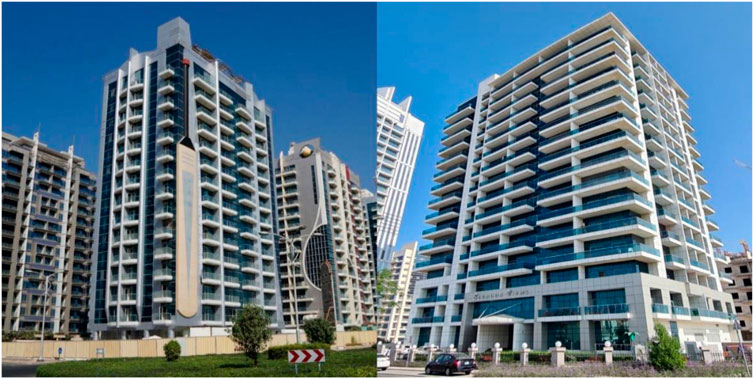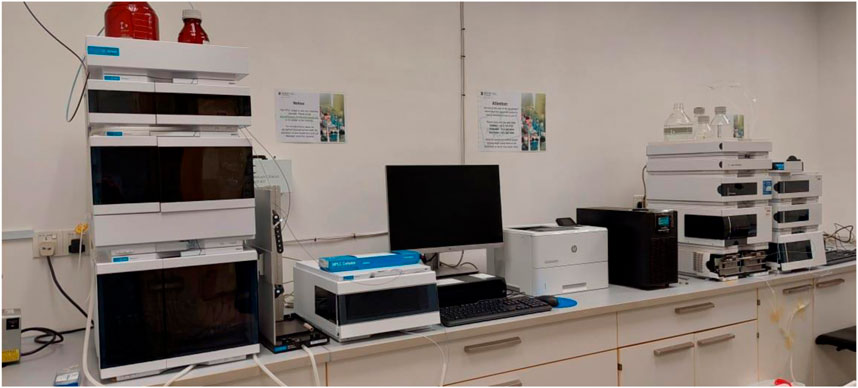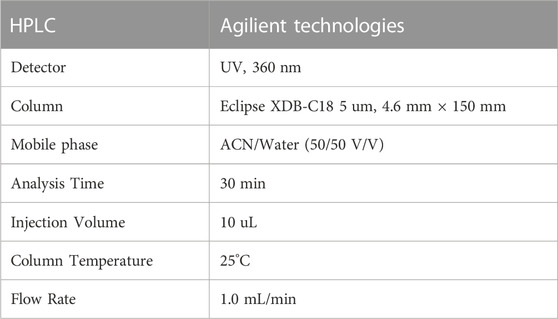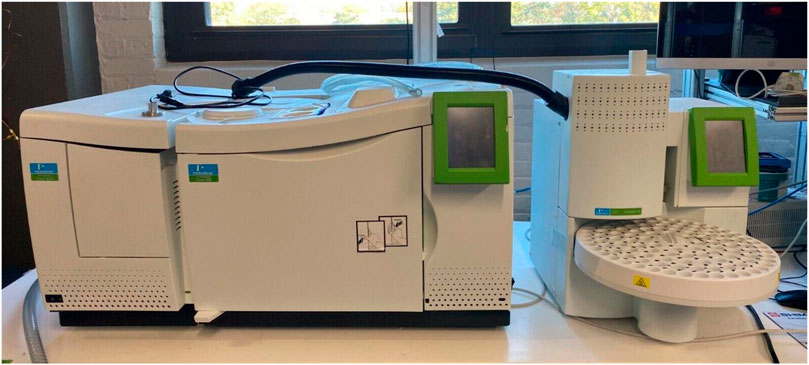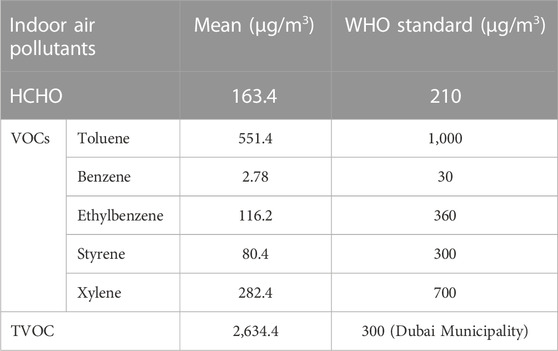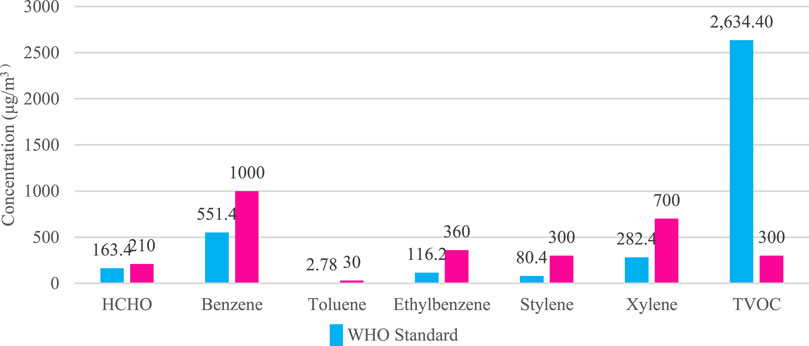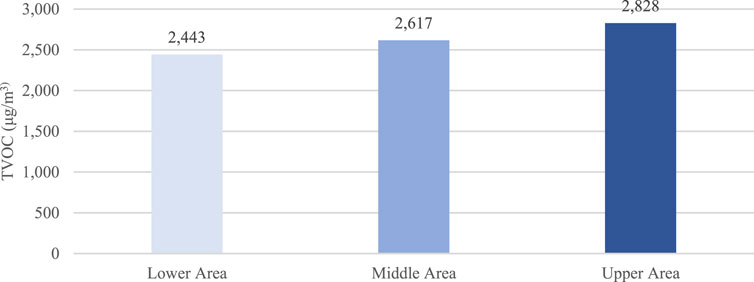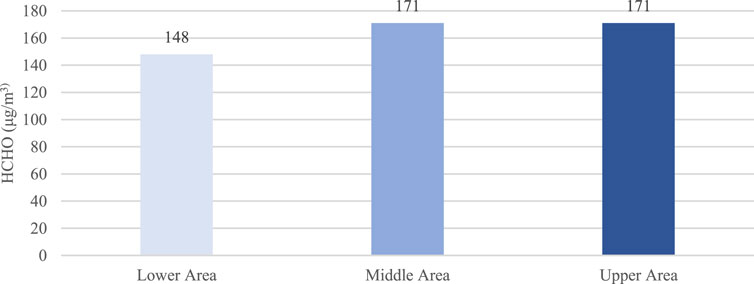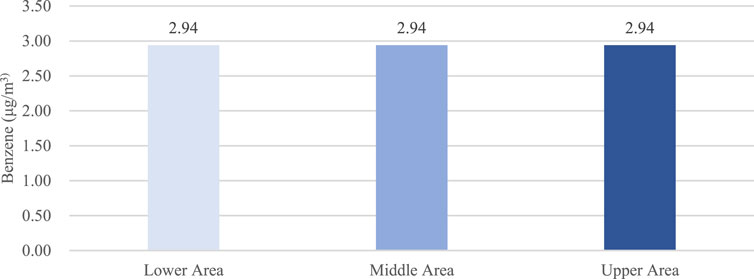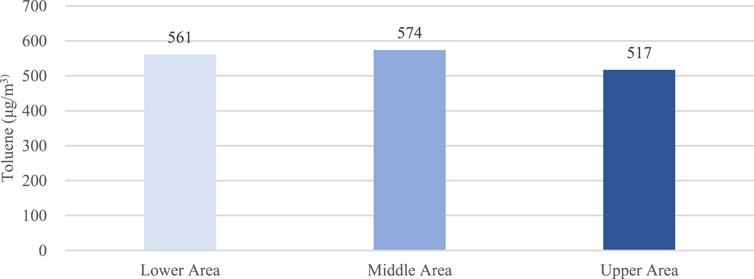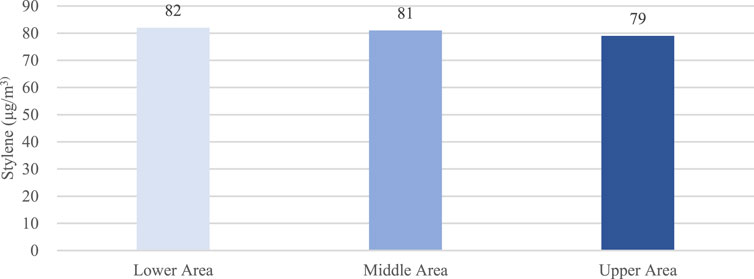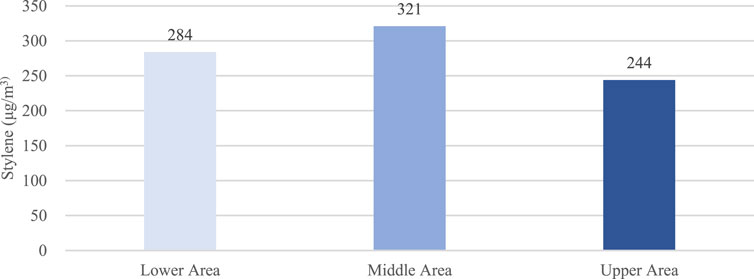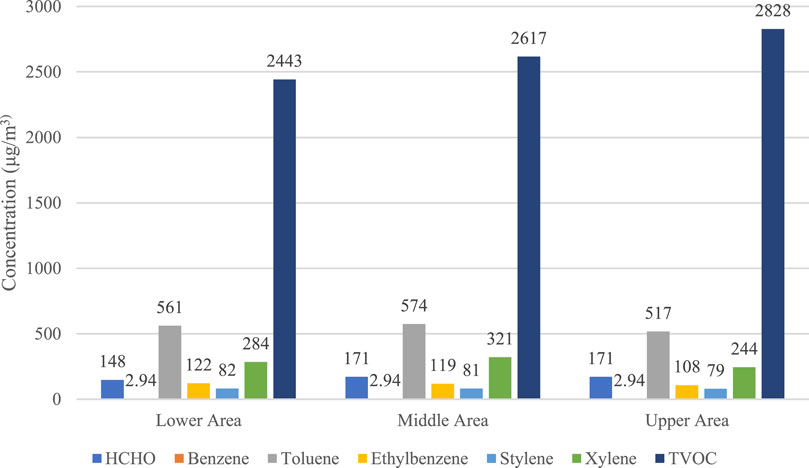Enhancing indoor air quality and sustainable living in newly constructed apartments: insights from Dubai
- 1Department of Architectural Engineering, College of Engineering, University of Sharjah, Sharjah, United Arab Emirates
- 2Department of Interior Design, College of Architecture, Art, and Design, Healthy and Sustainable Built Environment Research Center, Ajman University, Ajman, United Arab Emirates
- 3Department of Architecture, College of Architecture, Art, and Design, Ajman University, Ajman, United Arab Emirates
This research paper examines Indoor Air Quality (IAQ) conditions in newly constructed apartments in Dubai to be more sustainable for residents to have healthier lifestyles. Enhanced airtightness and chemical-laden materials contribute to IAQ pollution in these buildings. The study aims to assess pollutant concentrations and variations based on building height. Measurements were conducted in 12 apartment units using the WHO’s IAQ assessment methodology. Most pollutants were within limits, but TVOC exceeded the Dubai Municipality’s standard, measuring at 2634.4 μg/m³, approximately nine times higher than the standard. HCHO (163.4 μg/m³) and toluene (551.4 μg/m³) were identified as significant pollutants with potential health effects. Analysis of pollutant concentrations based on building height revealed higher TVOC levels in upper areas, with 2,828 μg/m³ in the upper area compared to 2,443 μg/m³ in the lower area, indicating more severe indoor air pollution in Ethylbenzene and styrene also highest in upper areas, with ethylbenzene at 122 μg/m³ and styrene at 82 μg/m³ in the upper area, potentially due to elevated sources. Toluene and xylene concentrations were elevated in the middle area, with toluene at 574 μg/m³ and xylene at 321 μg/m³, likely influenced by materials and occupant activities. Benzene concentrations were consistent across all heights at 2.94 μg/m³, suggesting a common source. HCHO concentrations were relatively consistent but slightly higher in the middle and upper areas, with 171 μg/m³ in both, likely influenced by ventilation and emissions. While average pollutant concentrations met WHO standards, many units exceeded recommended limits, requiring targeted interventions. The study highlights the importance of addressing IAQ concerns and implementing strategies to reduce indoor air pollutants and improve ventilation. These findings contribute to IAQ knowledge in Dubai’s residential buildings, guiding policymakers, architects, and developers in effective policies and guidelines. Further research on seasonal variations and other IAQ factors is recommended for better understanding and long-term monitoring. Prioritizing IAQ in newly constructed apartments is crucial for healthier living in Dubai. The residential building sector can protect residents’ health by implementing appropriate measures while delivering upscale living experiences.
1 Introduction
Dubai’s residential building sector has witnessed notable trends in the past decade (Alawadi, 2017; Alawadi et al., 2021; Awad and Jung, 2022). These trends exemplify Dubai’s dedication to innovation, sustainability, and delivering modern and upscale living experiences to its residents (Alawadi et al., 2018). Dubai’s residential building sector has experienced noteworthy challenges related to Indoor Air Quality (IAQ) pollution (Jung and Awad, 2021a; Awad and Jung, 2021). The significance of ventilation efficiency in the breathing zone, particularly for evaluating IAQ during sleep, demonstrates the complexities involved in IAQ management (Zuo and Malone Beach, 2017). The importance of designing efficient and healthy buildings, which resonates with the IAQ challenges in Dubai’s residential sector, is also underscored (McGill et al., 2015). These challenges have arisen due to the deterioration of ventilation performance resulting from the recent enhancement of airtightness in buildings and the increased utilization of building materials and furniture that contain substantial amounts of chemical substances in newly constructed apartments (Jung and Awad, 2021b; Mahmoud et al., 2023a). The significance of ventilation efficiency in the breathing zone, especially concerning evaluating IAQ during sleep, highlights the complexities of IAQ management (Hormigos-Jimenez et al., 2019). The need for designing efficient and healthy buildings is emphasized in alignment with the challenges faced in Dubai’s residential sector (González-Lezcano, 2023). The deterioration in IAQ, crucial in establishing a pleasant and healthy living environment, has naturally raised concerns (Jung et al., 2021a). Consequently, there has been a growing awareness of the impact of sick building syndrome, which has caused social issues in Dubai, further highlighting the significance of addressing IAQ concerns (Arar and Jung, 2021; Babich et al., 2023).
The initial occupancy phase of newly constructed apartment buildings is accompanied by the release of a significant quantity of chemical substances, posing a threat to the health of the residents (Jung et al., 2022a; Jung and El Samanoudy, 2023). Among these substances, formaldehyde (HCHO) and Volatile Organic Compounds (VOCs) are of particular concern, as they can have detrimental effects on individuals who spend prolonged periods in the affected residences, especially those who are more susceptible to environmental factors such as infants and the elderly (Mushtaha et al., 2021; Arar et al., 2022; Fantozzi et al., 2022). Exposure to these compounds can lead to various health issues (Mahmoud et al., 2023b; Jung and Awad, 2023). They can irritate the mucous membranes of the eyes, nose, and throat, resulting in dizziness, vomiting, and headaches (Jung et al., 2021b; Abdelaziz Mahmoud and Jung, 2023). In more severe cases, individuals may experience dermatitis and asthma exacerbation due to exposure to these substances (Jung and Mahmoud, 2022).
In 2013, the Public Health and Safety Department of Dubai Municipality took the initiative to extensively assess IAQ in various public buildings, encompassing educational institutions, universities, schools, nurseries, kindergartens, and healthcare centers (Al Qassimi and Jung, 2022; Kharrufa et al., 2022). This comprehensive evaluation led to the establishment of stringent regulations governing IAQ standards (Jung et al., 2021c). As per the established guidelines, the presence of HCHO should not exceed 0.08 parts per million (ppm), while the levels of Total Volatile Organic Compounds (TVOC) must not exceed 300 μg per cubic meter (µg/m3) (Arar and Jung, 2022; Jung et al., 2022b). Additionally, suspended particulate matter measuring less than 10 microns in size (PM10) should not surpass 150 μg per cubic meter (µg/m3) during continuous monitoring over 8 h before occupancy (Mannan and Al-Ghamdi, 2021). These stipulations were implemented to ensure the maintenance of optimal IAQ conditions, promoting a healthy and safe environment for occupants in these public buildings (Mushtaha et al., 2020; Ortiz et al., 2020).
It is crucial to gain a comprehensive and accurate understanding of the prevailing IAQ conditions to formulate effective policies and implement improvement measures addressing IAQ concerns in newly constructed apartments (Zhao et al., 2021; Jung et al., 2022c). To this end, a survey was conducted to ascertain the current state of IAQ in newly built apartments (Hildebrandt et al., 2019). However, this survey’s scope falls short compared to the comprehensive investigations undertaken in developed nations (Hou et al., 2023).
The existing surveys about newly constructed apartment houses have primarily focused on comparing indoor air pollutant concentrations based on occupancy, time, temperature, humidity, household size, and measurement location (Yu et al., 2020). However, studies that evaluate seasonal variations in IAQ characteristics are scarce, highlighting the need for further research in this area (Yin et al., 2022). Given the identified research gaps, this study aims to employ the World Health Organization’s (WHO) IAQ assessment methodology, measure and analyze IAQ immediately before occupancy in 12 newly constructed apartment units, and obtain an accurate assessment of IAQ in a recently constructed apartment.
2 Materials and methods
The comprehensive measurements were undertaken between December 2022 and January 2023 for an accurate assessment. A total of 12 units residing in two newly built apartments were included in the study. The focus of the measurements encompassed various pollutants, including Total Volatile Organic Compounds (TVOC), HCHO, and VOCs (Hussien et al., 2023a; Properties, 2023a). These pollutants were selected to evaluate their presence and levels within the indoor environment.
2.1 Target buildings
The selected buildings for assessing the IAQ conditions in newly constructed apartment complexes are Tennis Tower and Bermuda Views in Dubai Sports City (Figure 1) (Chiesa et al., 2019; Properties, 2023b). The study focuses on six 1-bedroom units within each building specifically targeted for measurement purposes (Figure 2). The selected units were stratified based on floor levels to ensure a comprehensive representation. Each pair of units on different floors was chosen to be measured, allowing for a diverse sampling approach (Parkinson et al., 2019). Among the total units included in the study, low-rise units accounted for one-third, middle-rise units accounted for one-third, and high-rise units accounted for one-third (Zhang et al., 2021). The distribution of units across different floor levels exhibited a similar pattern among the measured units (Table 1) (Földváry et al., 2017).
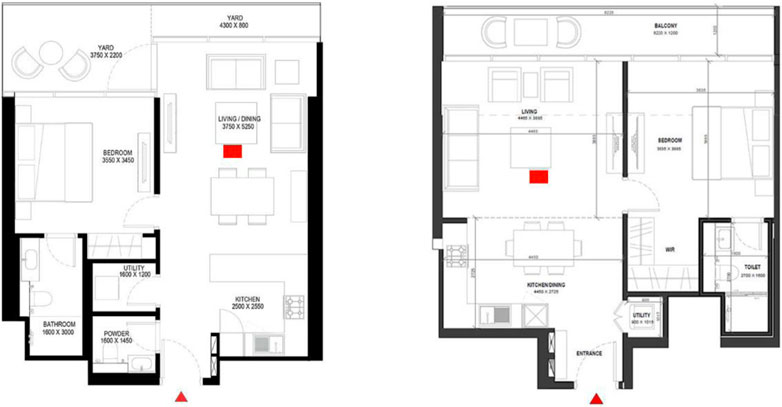
FIGURE 2. One bedroom plan of Tennis Tower (left) and Bermuda views (right) showing the measurement points.
2.2 Measurement and analysis method
The measurements followed the World Health Organization’s (WHO) recommended IAQ assessment methodology for newly built apartments (Singer et al., 2020; Hussien et al., 2023b). The procedure involved a ventilation period of 30 min, followed by keeping the target unit’s room open for over 5 h (Bekö et al., 2020). Subsequently, the openings were sealed, and samples were collected twice, each lasting approximately 30 min (Zhong et al., 2022).
Consistent with the prescribed test method, the sampling occurred between 1:00 p.m. and 5:00 p.m. The samples were collected at the center of the living room in each unit, which served as the primary sampling location (Ho et al., 2018). To measure HCHO levels, a portable pump (Flec-FL1001, Sibata) was employed in conjunction with an ozone scrubber containing high-purity potassium iodide (KI) (Zhao et al., 2017; Wei et al., 2020). This configuration effectively eliminated any interference from ozone (Souza et al., 2020). A 2,4-DNPH (dinitrophenylhydrazine) cartridge coated with 350 mg of silica was also utilized for HCHO sampling (Zou et al., 2020). For the collection of VOCs, a Tenax tube was connected to the same pump, and samples were collected for 30 min (Huang et al., 2018).
For the analysis of HCHO, a series of standard solutions ranging from 0.1 to 10 ppm were prepared by diluting the standard stock solution (Hwang et al., 2017). A calibration curve was subsequently established using these solutions. The collected DNPH cartridges were affixed onto a solid phase extraction (SPE) vacuum manifold and subjected to extraction using 5 mL of acetonitrile of high-performance liquid chromatography (HPLC) grade (Figure 3) (Zhang et al., 2019). The resulting extracts were then injected into an HPLC-UV system for analysis. Specific analysis conditions for HCHO can be found in Table 2.
Regarding the analysis of VOCs, a standard gas was diluted, and two or three standard substances were prepared within the concentration range of 0.1–1 ppm (Sui et al., 2021). These standards were utilized to establish a calibration curve (Table 3). The concentration of each standard substance was selected to encompass potential concentrations found in unknown samples (Hwang and Park, 2019). Following sample collection, the solid adsorption tubes were subjected to desorption and concentration processes (Vardoulakis et al., 2020). Subsequently, two-stage thermal desorption was performed, and the desorbed samples were injected into a gas chromatography/mass spectroscopy (GC/MS) system for analysis (Figure 4) (Kakoulli et al., 2022).
3 Results
3.1 Average concentration of pollutants
The temperature recorded was 25.0°C during the measurement period, while the relative humidity (RH) was measured at 61.4%. Following the assessment of IAQ in a total of 12 units (six units each from Tennis Tower and Bermuda Views located in Dubai Sports City) before occupancy, the average results indicate that all contaminants measured meet the recommended standards set by the WHO. The concentration levels observed were as follows: HCHO measured at 163.4 μg/m3, toluene at 551.4 μg/m3, benzene at 2.78 μg/m3, ethylbenzene at 2.78 μg/m3, styrene at 80.4 μg/m3, and xylene at 282.4 μg/m3. Notably, the TVOC level was measured at 2,634.4 μg/m3, approximately 9 times higher than the standard set by the Dubai Municipality (Table 4).
Benzene, ethylbenzene, styrene, and xylene were at very low levels compared to the recommended standards. However, HCHO levels reached 80% of the WHO’s recommended 210 μg/m3 standard. When comparing the measurement results of each unit with the WHO’s recommended standards, it is evident that a significant number of households exceed the established standards (Figure 5).
Based on these findings, it is imperative to develop targeted measures to address indoor air pollutants, particularly formaldehyde (HCHO) and toluene. Intensive actions are required to mitigate their concentrations and ensure compliance with the recommended standards.
3.2 Average concentration of pollutants according to building height
According to the WHO’s IAQ process test method, the average concentrations of pollutants measured across different building heights were as follows: for TVOC, 2,443 μg/m3 in the lower area, 2,617 μg/m3 in the middle area, and 2,828 μg/m3 in the upper area.
To provide a comprehensive overview of the pollutant concentration variations across different building heights, the following table (Table 5) summarizes the average concentrations of each pollutant in the buildings’ lower, middle, and upper areas.
While the table provides a succinct summary of the average pollutant concentrations across different building heights, Figures 6–12 provide a detailed visual representation, offering an additional perspective on the data distribution and trends observed in the study.
For HCHO, the average concentrations were 148 μg/m3 in the lower area, 171 μg/m3 in the middle area, and 171 μg/m3 in the upper area (Figure 7). The average benzene concentrations were consistent at 2.94 μg/m3 across all building heights (Figure 8). Toluene exhibited the highest concentration in the middle area at 574 μg/m3, 561 μg/m3 in the upper area, and 517 μg/m3 in the lower area (Figure 9).
Regarding ethylbenzene, the highest concentration was detected in the upper area at 122 μg/m3, followed by 119 μg/m3 in the middle and 108 μg/m3 in the lower area (Figure 10). Styrene demonstrated the highest concentration in the upper area at 82 μg/m3, 81 μg/m3 in the middle area, and 79 μg/m3 in the lower area (Figure 11). Regarding xylene, the highest concentration was found in the middle area at 321 μg/m3, followed by 284 μg/m3 in the upper area and 244 μg/m3 in the lower area (Figure 12).
Analyzing the concentration characteristics of pollutants by building height, it is evident that substances such as TVOC, ethylbenzene, and styrene exhibited higher concentrations in the upper area, with concentrations decreasing in the middle and lower areas. In contrast, toluene and xylene displayed the highest concentrations in the middle area, with concentrations decreasing in the upper and lower areas. Benzene exhibited similar concentrations across all building heights. Regarding HCHO, the concentrations in the upper and middle areas were comparable, while the concentration in the lower area was lower than in the middle and upper areas (Figure 13).
4 Discussion
The findings derived from the IAQ measurements conducted in the selected apartment units offer valuable insights into the levels of indoor air pollutants present in Dubai’s residential buildings (Chang et al., 2017). Overall, the HCHO, benzene, toluene, ethylbenzene, styrene, and xylene concentrations were within the acceptable limits set by the WHO (Ilies et al., 2022). However, it is noteworthy that the concentration of TVOC was significantly higher than the standard established by the Dubai Municipality (Martinez et al., 2022).
Certain patterns emerge upon analyzing the average concentrations of pollutants based on building height (Al-Hemoud et al., 2017). The TVOC levels were observed to be highest in the upper area, followed by the middle and lower areas (Chan and Liu, 2018). This indicates that indoor air pollution may be more pronounced in high-rise units than in their lower-level counterparts (Jung and Al Qassimi, 2022). Similarly, the concentrations of ethylbenzene and styrene were also highest in the upper area, suggesting potential sources of these pollutants at elevated elevations.
In contrast, toluene and xylene exhibited higher concentrations in the middle area, implying that factors such as building materials, furnishings, or occupant activities may contribute to the elevated levels of these volatile organic compounds, such as household cleaning products, painting or hobbies activities involving chemicals, and smoking. The consistent benzene concentrations across all building heights suggest a common source of this pollutant within the apartment units.
The average concentration of HCHO demonstrated relatively consistent levels across all building heights, with slightly higher concentrations detected in the middle and upper areas compared to the lower area. This may be attributed to variations in ventilation and emission sources within the individual units.
The significance of these findings lies in their practical application for improving indoor air quality in residential buildings. By identifying specific pollutants and their concentration patterns related to building height, our study provides crucial data for architects, engineers, and policymakers. This information can guide the design of ventilation systems, the selection of building materials, and the development of regulations to ensure healthier indoor environments. Additionally, recognizing the elevated levels of certain pollutants in specific building areas can inform targeted interventions and maintenance practices to mitigate these risks.
The elevated levels of TVOC, surpassing the standard set by the Dubai Municipality, underscore the necessity for comprehensive measures to address indoor air pollution in newly constructed apartments. Effective strategies should focus on mitigating the emissions of volatile organic compounds and promoting the implementation of proper ventilation systems to enhance IAQ.
Importantly, while the average concentrations of pollutants met the WHO standards, a notable proportion of individual units exceeded the recommended limits. This suggests the presence of specific sources or factors contributing to higher pollutant levels in certain households. Further investigation and targeted interventions are essential to address these units exhibiting elevated concentrations of pollutants.
This study comprehensively evaluates IAQ in newly constructed apartments in Dubai. The results underscore the importance of addressing indoor air pollution and implementing measures to ensure healthier living environments for residents. The findings serve as a foundation for developing policies and guidelines to improve IAQ in residential buildings, ultimately enhancing the overall wellbeing of occupants.
While this study provides valuable insights into the indoor air quality of newly constructed apartments in Dubai, it is important to acknowledge certain limitations. The dataset primarily focused on average concentrations of various contaminants and did not extend to detailed statistical analyses such as calculating standard deviations or identifying maximum values for each pollutant. Recognizing this, future studies should encompass a broader data collection scope, allowing for a more comprehensive statistical analysis. This would include averages, deviations, maximums, and potentially other statistical measures to provide a more detailed understanding of indoor air quality variations over time and across different environmental conditions. Furthermore, considering the observed higher levels of TVOC in high-end apartments, future research should also explore the potential correlation between the number of indoor plants and the concentration of volatile organic particles, providing insights into natural methods of improving indoor air quality. Such an expanded approach would significantly enhance our understanding of indoor air quality dynamics and contribute to developing more robust health and safety standards in residential environments.
5 Conclusion
This study offers valuable insights into the IAQ conditions prevalent in newly constructed apartments in Dubai. Identifying trends and challenges in the residential building sector underscores the significance of addressing IAQ concerns. Measurements conducted using the WHO’s IAQ assessment methodology indicate that while most pollutants fall within acceptable limits, TVOC levels exceed the standard set by the Dubai Municipality, with an average concentration of 2634.4 μg/m³, approximately 9 times higher than the standard.
Significantly, we observed variations in pollutant concentrations based on building height, with TVOC concentrations being 2,443 μg/m³ in the lower area, 2,617 μg/m³ in the middle area, and 2,828 μg/m³ in the upper area. HCHO concentrations were relatively consistent but slightly higher in the middle and upper areas, measuring 171 μg/m³, compared to 148 μg/m³ in the lower area. Toluene showed the highest concentration in the middle area at 574 μg/m³.
We propose implementing tailored strategies and interventions specific to each building’s height to address these variations effectively. For instance, in the upper areas where TVOC concentrations are highest, strategies could include enhanced ventilation, air purification systems, and regular air quality monitoring. In the middle areas, where toluene concentrations are elevated, interventions could focus on controlling sources of toluene, such as specific building materials or occupant activities. Similarly, although pollutant levels are comparatively lower for lower areas, maintaining regular IAQ assessments and ensuring adequate ventilation would be essential to prevent any potential increase in contaminant levels. By implementing these height-specific interventions, it is possible to ensure compliance with recommended IAQ standards across all building levels, enhancing the residents’ overall air quality and health safety.
The analysis of pollutant concentrations based on building height reveals variations in indoor air pollution levels, with specific pollutants demonstrating higher concentrations in certain areas. These findings necessitate targeted interventions to mitigate indoor air pollutants and enhance IAQ, particularly concerning HCHO and toluene. Moreover, the results indicate that many individual units surpass recommended IAQ standards, highlighting the presence of specific sources or factors contributing to heightened pollutant levels. Developing tailored strategies and interventions is crucial to address these units and ensure compliance with recommended standards.
To raise awareness among architects, engineers, builders, owners, and companies using materials with high chemical content, our findings emphasize these stakeholders’ critical role in creating healthier indoor environments. Collaborative efforts are needed to develop and adopt materials and building practices that reduce indoor pollutant levels. We recommend targeted educational and outreach programs, incorporating our study’s findings, to inform and engage these key stakeholders in a dialogue about sustainable and health-conscious building practices. Our research underscores the shared responsibility in ensuring IAQ standards are met, and these collaborative efforts can lead to solutions that benefit all parties involved, including the residents.
This research significantly contributes to existing knowledge by providing a comprehensive assessment of IAQ in newly constructed apartments, underscoring the importance of considering IAQ during residential building design and construction. The findings serve as a valuable guide for policymakers, architects, and developers in formulating effective policies and guidelines to foster healthier living environments and enhance resident wellbeing.
Acknowledging the limitations of our study, particularly the focus on average contaminant concentrations without a detailed statistical analysis, we suggest that future research endeavors could include a broader scope of data collection. This expanded approach should encompass deviations, maximums, and other statistical measures to provide a more detailed understanding of IAQ variations. Moreover, focusing on seasonal variations in IAQ characteristics and exploring additional factors influencing indoor air pollutant concentrations could further advance the understanding of IAQ in Dubai’s residential buildings. Implementing long-term monitoring and evaluation programs can provide valuable data for assessing the effectiveness of interventions and ensuring sustained improvements in IAQ.
Addressing IAQ concerns in newly constructed apartments is paramount for creating healthier and more sustainable living environments in Dubai. By prioritizing IAQ and implementing appropriate measures, the residential building sector can continue to deliver modern and upscale living experiences while safeguarding the health and wellbeing of residents. Our study emphasizes the importance of addressing IAQ concerns and outlines several key strategies that can be implemented:
1. Reducing Volatile Organic Compounds (VOCs): Implementing measures to reduce the presence and emission of VOCs in residential units. This involves carefully selecting and using building materials and low-chemical content furnishings.
2. Proper Ventilation Systems: Promoting effective and proper ventilation systems in residential buildings. Adequate ventilation is crucial for diluting and removing indoor air pollutants, improving IAQ.
3. Targeted Interventions: Addressing elevated concentrations of pollutants in individual units through further investigation and targeted interventions. This suggests the need for custom approaches depending on the specific sources or factors contributing to higher pollutant levels in certain households.
4. Policy Development and Guidelines: Our findings are a foundation for developing policies and guidelines to improve IAQ in residential buildings. Policymakers, architects, and developers can use this data to formulate effective strategies for healthier living environments.
5. Public Awareness and Education: Raising awareness among residents and stakeholders about the importance of IAQ and the measures that can be taken to improve it.
Data availability statement
The raw data supporting the conclusion of this article will be made available by the authors, without undue reservation.
Author contributions
CJ: Conceptualization, Data curation, Formal Analysis, Methodology, Resources, Validation, Visualization, Writing–original draft. NSA: Data curation, Investigation, Methodology, Project administration, Software, Supervision, Writing–review and editing. NA: Investigation, Project administration, Supervision, Validation, Visualization, Writing–review and editing.
Funding
The author(s) declare that no financial support was received for the research, authorship, and/or publication of this article.
Acknowledgments
The authors would like to express their gratitude to University of Sharjah and Ajman University for APC support and providing great research environment.
Conflict of interest
The authors declare that the research was conducted in the absence of any commercial or financial relationships that could be construed as a potential conflict of interest.
Publisher’s note
All claims expressed in this article are solely those of the authors and do not necessarily represent those of their affiliated organizations, or those of the publisher, the editors and the reviewers. Any product that may be evaluated in this article, or claim that may be made by its manufacturer, is not guaranteed or endorsed by the publisher.
References
Abdelaziz Mahmoud, N. S., and Jung, C. (2023). Analyzing the bake-out effect in winter for the enhancement of indoor air quality at new apartments in UAE. Buildings 13 (4), 846. doi:10.3390/buildings13040846
Alawadi, K. (2017). Rethinking Dubai’s urbanism: generating sustainable form-based urban design strategies for an integrated neighborhood. Cities 60, 353–366. doi:10.1016/j.cities.2016.10.012
Alawadi, K., Khaleel, S., and Benkraouda, O. (2021). Design and planning for accessibility: lessons from abu dhabi and dubai’s neighborhoods. J. Hous. Built Environ. 36, 487–520. doi:10.1007/s10901-020-09763-3
Alawadi, K., Khanal, A., and Almulla, A. (2018). Land, urban form, and politics: a study on Dubai’s housing landscape and rental affordability. Cities 81, 115–130. doi:10.1016/j.cities.2018.04.001
Al-Hemoud, A., Al-Awadi, L., Al-Rashidi, M., Rahman, K. A., Al-Khayat, A., and Behbehani, W. (2017). Comparison of indoor air quality in schools: urban vs. Industrial’oil & gas' zones in Kuwait. Build. Environ. 122, 50–60. doi:10.1016/j.buildenv.2017.06.001
Al Qassimi, N., and Jung, C. (2022). Impact of air-purifying plants on the reduction of volatile organic compounds in the indoor hot desert climate. Front. Built Environ. 7, 188. doi:10.3389/fbuil.2021.803516
Arar, M., and Jung, C. (2021). Improving the indoor air quality in nursery buildings in United Arab Emirates. Int. J. Environ. Res. Public Health 18 (22), 12091. doi:10.3390/ijerph182212091
Arar, M., and Jung, C. (2022). Analyzing the perception of indoor air quality (IAQ) from a survey of new townhouse residents in Dubai. Sustainability 14 (22), 15042. doi:10.3390/su142215042
Arar, M., Jung, C., and Qassimi, N. A. (2022). Investigating the influence of the building material on the indoor air quality in apartment in Dubai. Front. Built Environ. 7, 804216. doi:10.3389/fbuil.2021.804216
Awad, J., and Jung, C. (2021). Evaluating the indoor air quality after renovation at the Greens in Dubai, United Arab Emirates. Buildings 11 (8), 353. doi:10.3390/buildings11080353
Awad, J., and Jung, C. (2022). Extracting the planning elements for sustainable urban regeneration in Dubai with AHP (analytic hierarchy process). Sustain. Cities Soc. 76, 103496. doi:10.1016/j.scs.2021.103496
Babich, F., Torriani, G., Corona, J., and Lara-Ibeas, I. (2023). Comparison of indoor air quality and thermal comfort standards and variations in exceedance for school buildings. J. Build. Eng. 71, 106405. doi:10.1016/j.jobe.2023.106405
Bekö, G., Wargocki, P., Wang, N., Li, M., Weschler, C. J., Morrison, G., et al. (2020). The indoor chemical human emissions and reactivity (ICHEAR) project: overview of experimental methodology and preliminary results. Indoor Air 30 (6), 1213–1228. doi:10.1111/ina.12687
Chan, I. Y., and Liu, A. M. (2018). Effects of neighborhood building density, height, greenspace, and cleanliness on indoor environment and health of building occupants. Build. Environ. 145, 213–222. doi:10.1016/j.buildenv.2018.06.028
Chang, T., Ren, D., Shen, Z., Huang, Y., Sun, J., Cao, J., et al. (2017). Indoor air pollution levels in decorated residences and public places over Xi’an, China. Aerosol Air Qual. Res. 17 (9), 2197–2205. doi:10.4209/aaqr.2016.12.0542
Chiesa, G., Cesari, S., Garcia, M., Issa, M., and Li, S. (2019). Multisensor IoT platform for optimising IAQ levels in buildings through a smart ventilation system. Sustainability 11 (20), 5777. doi:10.3390/su11205777
Fantozzi, F., Lamberti, G., Leccese, F., and Salvadori, G. (2022). Monitoring CO2 concentration to control the infection probability due to airborne transmission in naturally ventilated university classrooms. Archit. Sci. Rev. 65 (4), 306–318. doi:10.1080/00038628.2022.2080637
Földváry, V., Bekö, G., Langer, S., Arrhenius, K., and Petráš, D. (2017). Effect of energy renovation on indoor air quality in multifamily residential buildings in Slovakia. Build. Environ. 122, 363–372. doi:10.1016/j.buildenv.2017.06.009
González-Lezcano, R. A. (2023). Editorial: design of efficient and healthy buildings. Front. Built Environ. 9. Frontiers Media S.A. doi:10.3389/fbuil.2023.1210956
Hildebrandt, S., Kubota, T., Sani, H. A., and Surahman, U. (2019). Indoor air quality and health in newly constructed apartments in developing countries: a case study of Surabaya, Indonesia. Atmosphere 10 (4), 182. doi:10.3390/atmos10040182
Ho, S. S. H., Wang, L., Chow, J. C., Watson, J. G., Xue, Y., Huang, Y., et al. (2018). Optimization and evaluation of multi-bed adsorbent tube method in collection of volatile organic compounds. Atmos. Res. 202, 187–195. doi:10.1016/j.atmosres.2017.11.026
Hormigos-Jimenez, S., Padilla-Marcos, M. Á., Meiss, A., Gonzalez-Lezcano, R. A., and Feijó-Muñoz, J. (2019). Assessment of the ventilation efficiency in the breathing zone during sleep through computational fluid dynamics techniques. J. Build. Phys. 42 (4), 458–483. doi:10.1177/1744259118771314
Hou, H. C., Zhang, D., and Lai, J. H. (2023). Qualitative and quantitative investigation into the indoor built environment of modular student housing: a multiple-room case study. Energy Build. 280, 112734. doi:10.1016/j.enbuild.2022.112734
Huang, K., Song, J., Feng, G., Chang, Q., Jiang, B., Wang, J., et al. (2018). Indoor air quality analysis of residential buildings in northeast China based on field measurements and longtime monitoring. Build. Environ. 144, 171–183. doi:10.1016/j.buildenv.2018.08.022
Hussien, A., Jannat, N., Mushtaha, E., and Al-Shammaa, A. (2023b). A holistic plan of flat roof to green-roof conversion: towards a sustainable built environment. Ecol. Eng. 190, 106925. doi:10.1016/j.ecoleng.2023.106925
Hussien, A., Saleem, A. A., Mushtaha, E., Jannat, N., Al-Shammaa, A., Ali, S. B., et al. (2023a). A statistical analysis of life cycle assessment for buildings and buildings’ refurbishment research. Ain Shams Eng. J. 14, 102143. doi:10.1016/j.asej.2023.102143
Hwang, S. H., and Park, W. M. (2019). Indoor air quality assessment with respect to culturable airborne bacteria, total volatile organic compounds, formaldehyde, PM 10, CO 2, NO 2, and O 3 in underground subway stations and parking lots. Air Qual. Atmos. Health 12, 435–441. doi:10.1007/s11869-019-00666-z
Hwang, S. H., Seo, S., Yoo, Y., Kim, K. Y., Choung, J. T., and Park, W. M. (2017). Indoor air quality of daycare centers in Seoul, Korea. Build. Environ. 124, 186–193. doi:10.1016/j.buildenv.2017.07.042
Ilies, A., Caciora, T., Marcu, F., Berdenov, Z., Ilieș, G., Safarov, B., et al. (2022). Analysis of the interior microclimate in art nouveau heritage buildings for the protection of exhibits and human health. Int. J. Environ. Res. Public Health 19 (24), 16599. doi:10.3390/ijerph192416599
Jung, C., and Al Qassimi, N. (2022). Investigating the emission of hazardous chemical substances from mashrabiya used for indoor air quality in hot desert climate. Sustainability 14 (5), 2842. doi:10.3390/su14052842
Jung, C., Al Qassimi, N., Abdelaziz Mahmoud, N. S., and Lee, S. Y. (2022c). Analyzing the housing consumer preferences via analytic hierarchy process (AHP) in Dubai, United Arab Emirates. Behav. Sci. 12 (9), 327. doi:10.3390/bs12090327
Jung, C., Alqassimi, N., and El Samanoudy, G. (2022b). Evaluating the adsorption performance of functional building material with HCHO remover. Front. Built Environ. 179. doi:10.3389/fbuil.2022.998872
Jung, C., and Awad, J. (2021a). The improvement of indoor air quality in residential buildings in Dubai, UAE. Buildings 11 (6), 250. doi:10.3390/buildings11060250
Jung, C., and Awad, J. (2021b). Improving the IAQ for learning efficiency with indoor plants in university classrooms in Ajman, United Arab Emirates. Buildings 11 (7), 289. doi:10.3390/buildings11070289
Jung, C., and Awad, J. (2023). Sharjah sustainable city: an analytic hierarchy process approach to urban planning priorities. Sustainability 15 (10), 8217. doi:10.3390/su15108217
Jung, C., Awad, J., and Al Qassimi, N. (2021b). Analyzing the users’ satisfaction levels and perceptions of the Dubai water canal for future waterfront development in UAE. Future Cities Environ. 7 (1). doi:10.5334/fce.134
Jung, C., Awad, J., and Al Qassimi, N. (2021c). Evaluation of residents’ comfort in high-rise residential buildings in Dubai, United Arab Emirates. Front. Built Environ. 145. doi:10.3389/fbuil.2021.766057
Jung, C., Awad, J., Sami Abdelaziz Mahmoud, N., and Salameh, M. (2021a). An analysis of indoor environment evaluation for the Springs development in Dubai, UAE. Open House Int. 46 (4), 651–667. doi:10.1108/ohi-11-2020-0165
Jung, C., Awad, R., and Awad, J. (2022a). A study of optimal design process for complex-shaped skyscrapers’ structural systems in United Arab Emirates. Ain Shams Eng. J. 13 (5), 101683. doi:10.1016/j.asej.2021.101683
Jung, C., and El Samanoudy, G. (2023). Mitigating indoor air pollution in university dormitory: the need for better ventilation and resident awareness. Buildings 13 (5), 1144. doi:10.3390/buildings13051144
Jung, C., and Mahmoud, N. S. A. (2022). Extracting the critical points of formaldehyde (HCHO) emission model in hot desert climate. Air, Soil Water Res. 15, 117862212211050. doi:10.1177/11786221221105082
Kakoulli, C., Kyriacou, A., and Michaelides, M. P. (2022). A review of field measurement studies on thermal comfort, indoor air quality and virus risk. Atmosphere 13 (2), 191. doi:10.3390/atmos13020191
Kharrufa, S. N., Awad, J., Jung, C., and Sherzad, M. (2022). Evaluating an active low-energy cooling upgrade to the building envelope in the hot climates of the Middle East. Int. J. Low-Carbon Technol. 17, 118–129. doi:10.1093/ijlct/ctab091
Mahmoud, N. S. A., El Samanoudy, G., and Jung, C. (2023a). Simulating the natural lighting for a physical and mental Well-being in residential building in Dubai, UAE. Ain Shams Eng. J. 14 (1), 101810. doi:10.1016/j.asej.2022.101810
Mahmoud, N. S. A., Jung, C., and Al Qassimi, N. (2023b). Evaluating the aircraft noise level and acoustic performance of the buildings in the vicinity of Dubai International Airport. Ain Shams Eng. J. 14 (8), 102032. doi:10.1016/j.asej.2022.102032
Mannan, M., and Al-Ghamdi, S. G. (2021). Indoor air quality in buildings: a comprehensive review on the factors influencing air pollution in residential and commercial structure. Int. J. Environ. Res. Public Health 18 (6), 3276. doi:10.3390/ijerph18063276
Martinez, I., Bruse, J. L., Florez-Tapia, A. M., Viles, E., and Olaizola, I. G. (2022). ArchABM: an agent-based simulator of human interaction with the built environment. CO2 and viral load analysis for indoor air quality. Build. Environ. 207, 108495. CO2 and viral load analysis for indoor air quality. doi:10.1016/j.buildenv.2021.108495
McGill, G., Oyedele, L. O., and McAllister, K. (2015). Case study investigation of indoor air quality in mechanically ventilated and naturally ventilated UK social housing. Int. J. Sustain. Built Environ. 4 (1), 58–77. doi:10.1016/j.ijsbe.2015.03.002
Mushtaha, E., Alsyouf, I., Al Labadi, L., Hamad, R., Khatib, N., and Al Mutawa, M. (2020). Application of AHP and a mathematical index to estimate livability in tourist districts: the case of Al Qasba in Sharjah. Front. Archit. Res. 9 (4), 872–889. doi:10.1016/j.foar.2020.04.001
Mushtaha, E., Shareef, S., Alsyouf, I., Mori, T., Kayed, A., Abdelrahim, M., et al. (2021). A study of the impact of major Urban Heat Island factors in a hot climate courtyard: the case of the University of Sharjah, UAE. UAE. Sustain. Cities Soc. 69, 102844. doi:10.1016/j.scs.2021.102844
Ortiz, M., Itard, L., and Bluyssen, P. M. (2020). Indoor environmental quality related risk factors with energy-efficient retrofitting of housing: a literature review. Energy Build. 221, 110102. doi:10.1016/j.enbuild.2020.110102
Parkinson, T., Parkinson, A., and de Dear, R. (2019). Continuous IEQ monitoring system: context and development. Build. Environ. 149, 15–25. doi:10.1016/j.buildenv.2018.12.010
Properties, F. (2023a). Tennis tower - Dubai Sports city. Available from: https://famproperties.com/dubai-sports-city/tennis-tower.
Properties, F. (2023b). Bermuda Views apartments - Dubai Sports city. Available from: https://famproperties.com/dubai-sports-city/bermuda-views.
Singer, B. C., Chan, W. R., Kim, Y. S., Offermann, F. J., and Walker, I. S. (2020). Indoor air quality in California homes with code-required mechanical ventilation. Indoor air 30 (5), 885–899. doi:10.1111/ina.12676
Souza, M. D. O., Sánchez, B., Fuentes, M., Gilaranz, J., and Canela, M. C. (2020). Analytical validation using a gas mixing system for the determination of gaseous formaldehyde. Anal. Methods 12 (43), 5247–5256. doi:10.1039/d0ay01363c
Sui, X., Tian, Z., Liu, H., Chen, H., and Wang, D. (2021). Field measurements on indoor air quality of a residential building in Xi’an under different ventilation modes in winter. J. Build. Eng. 42, 103040. doi:10.1016/j.jobe.2021.103040
Vardoulakis, S., Giagloglou, E., Steinle, S., Davis, A., Sleeuwenhoek, A., Galea, K. S., et al. (2020). Indoor exposure to selected air pollutants in the home environment: a systematic review. Int. J. Environ. Res. public health 17 (23), 8972. doi:10.3390/ijerph17238972
Wei, X., Shao, S., Ding, X., Jiao, W., and Liu, Y. (2020). Degradation of phenol with heterogeneous catalytic ozonation enhanced by high gravity technology. J. Clean. Prod. 248, 119179. doi:10.1016/j.jclepro.2019.119179
Yin, Y., He, J., Zhao, L., Pei, J., Yang, X., Sun, Y., et al. (2022). Identification of key volatile organic compounds in aircraft cabins and associated inhalation health risks. Environ. Int. 158, 106999. doi:10.1016/j.envint.2021.106999
Yu, J., Kang, Y., and Zhai, Z. J. (2020). Advances in research for underground buildings: energy, thermal comfort and indoor air quality. Energy Build. 215, 109916. doi:10.1016/j.enbuild.2020.109916
Zhang, H., Srinivasan, R., and Ganesan, V. (2021). Low cost, multi-pollutant sensing system using raspberry pi for indoor air quality monitoring. Sustainability 13 (1), 370. doi:10.3390/su13010370
Zhang, T., Li, X., Zhao, Q., and Rao, Y. (2019). Control of a novel synthetical index for the local indoor air quality by the artificial neural network and genetic algorithm. Sustain. Cities Soc. 51, 101714. doi:10.1016/j.scs.2019.101714
Zhao, H., Chan, W. R., Cohn, S., Delp, W. W., Walker, I. S., and Singer, B. C. (2021). Indoor air quality in new and renovated low-income apartments with mechanical ventilation and natural gas cooking in California. Indoor air 31 (3), 717–729. doi:10.1111/ina.12764
Zhao, Z., Dong, W., Wang, H., Chen, G., Wang, W., Liu, Z., et al. (2017). Advanced oxidation removal of hypophosphite by O3/H2O2 combined with sequential Fe (II) catalytic process. Chemosphere 180, 48–56. doi:10.1016/j.chemosphere.2017.04.003
Zhong, K., Chen, X., Meng, Q., Ran, M., Zhang, Z., Liu, X., et al. (2022). Application of the air-pipe rack heat exchanger heating system in residential buildings of Guangzhou. J. Build. Eng. 61, 105280. doi:10.1016/j.jobe.2022.105280
Zou, Z., He, J., and Yang, X. (2020). An experimental method for measuring VOC emissions from individual human whole-body skin under controlled conditions. Build. Environ. 181, 107137. doi:10.1016/j.buildenv.2020.107137
Keywords: formaldehyde (HCHO), volatile organic compounds (VOCs), indoor air quality (IAQ), new apartment, Dubai residential buildings
Citation: Jung C, Abdelaziz Mahmoud NS and Alqassimi N (2023) Enhancing indoor air quality and sustainable living in newly constructed apartments: insights from Dubai. Front. Built Environ. 9:1292531. doi: 10.3389/fbuil.2023.1292531
Received: 11 September 2023; Accepted: 06 December 2023;
Published: 21 December 2023.
Edited by:
Salwa K. Mohamed Hassan, National Research Centre, EgyptReviewed by:
Giacomo Salvadori, University of Pisa, ItalyRoberto Alonso González-Lezcano, CEU San Pablo University, Spain
Copyright © 2023 Jung, Abdelaziz Mahmoud and Alqassimi. This is an open-access article distributed under the terms of the Creative Commons Attribution License (CC BY). The use, distribution or reproduction in other forums is permitted, provided the original author(s) and the copyright owner(s) are credited and that the original publication in this journal is cited, in accordance with accepted academic practice. No use, distribution or reproduction is permitted which does not comply with these terms.
*Correspondence: Naglaa Sami Abdelaziz Mahmoud, n.abdelaziz@ajman.ac.ae
 Chuloh Jung
Chuloh Jung Naglaa Sami Abdelaziz Mahmoud
Naglaa Sami Abdelaziz Mahmoud Nahla Alqassimi
Nahla Alqassimi